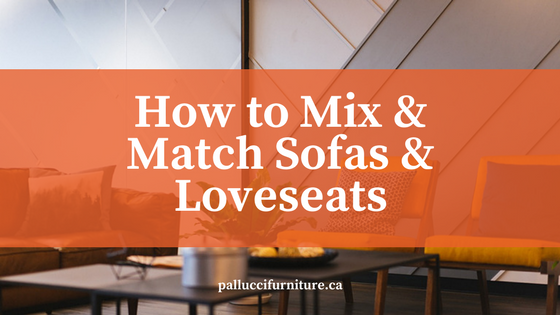Mix & Match Sofas & Love seats
The first rule of mixing and matching furniture is: there are no rules. Creative freedom and eclecticism are the spice of life when it comes to designing your perfect living room space. Adding a whiff of colour here, some textural fabric here, and a sleek leather over there are all perfectly suitable expressions of your inner designer.
The key to making all of your selections play nicely together, however, is the real trick. Mixing and matching furniture selections can be especially rewarding when you consider how styles and design schools can overlap, interact, and complement each other. In this post, we’ll spill a few specific ways to mix and match sofas and loveseats that can help showcase your taste with innovative style in mind.
Old & New
Opposites attract. The very idea that pairing together polarizing pieces of furniture is even possible is a testament to the rigidity of the modern design world. Many interior design magazines, online personalities, designers and furniture makers are continually experimenting with the convergence of old and new in ways that make us ponder the evolution of style and furniture.
A great example of pairing together old and new furniture is by exposing and accentuating the character of your furniture. The natural aged look of a leather patina with a crisp new off-white fabric loveseat creates a blend of chic modernity while allowing the room to steep in subtle tones of implied experience, and maturity. This particular blending of old and new doesn’t stop with the visual or physical nature of furniture, but examines the histories and functionality of your furniture choices.
There’s also a sense of continuity when you successfully pair together old and new styles of furniture in the living room. There’s a sense of progression, and of passing on the torch, so to speak. This adds a somehow natural and obvious visual aesthetic to any room.
Traditional & Contemporary
Similarly, pairing together traditional and contemporary sofas and loveseats is a great way to boost the level of purpose in a room. When you go this route, it’s important to not let one outdo the other - pairing a traditional space with contemporary accents is all about balance.
The traditional build and implied strength of a mortise and tenon sofa with the acquired, angular look of a modern loveseat continues the evolution of your space; this helps to bring together the clean and simple appeal of contemporary designs with the rustic utility and comfort of traditional styles. This can also help to establish a visible push-and-pull between pieces that adds to the energy of the room.
Bridging the Gap
When you’re considering pairing together eclectic sofa and loveseat choices, it’s never a bad idea to try to tie them together using the rest of the room. Two bold patterns or colours can be united by a common influence - like' an area rug, or an accent wall for example.
Let’s imagine that your sofa and loveseat selections are creating a dynamic within the room that is promoting a degree of separation; you just can’t seem to blend them and find balance. Adding a neutrally beneficial area rug is a prime example of creativity helping to bridge the gap. As prophesied in the Arthashastra: the enemy of your enemy is your friend : use the rug to help broker a deal, so to speak, between two powerful pieces of furniture.
Similarly, a gallery wall or a fresh coat of paint can work wonders to promote togetherness. When the personalities of your two varying sofa and loveseat continually differ, a blank canvas of white paint can be the perfect solution to drawing attention away from their collective creativity - simply bridge the gap by creating differences elsewhere.
Colour Combos
We’ve discussed materials and styles of furniture as unifying forces while experimenting with mixing and matching sofas and loveseats in the living room - but one common weapon that is easily exercisable is colour.
Researching colour theory is a great way to gauge the potential for successfully mixing and matching different sofas and loveseats - as well as accessories - used to heighten drama in the room. Colours are typically used to dictate certain emotions within a space, but can also be used to settle an atmosphere. The Bucket Rule establishes roles for three types of colours within a room
- Dominant colours
- Secondary colours
- Accent colours
Using this rule helps to decipher which colour schemes, and how many colours to use in a room. For example, you could pair a traditional style sofa with a modern style of love seat and use a complementary colour scheme comprised colour scheme: 75% sofa, 25% loveseat, using opposing colours on the colour scale to help build a relationship between the two pieces of furniture. This rule can also be used with accessories like throw pillows, blankets and rugs - even wall colours.
Alternatively, you could use a monochromatic scheme to make your task even easier. Monochromatic use the same colour in different tints and tones - like light blues and dark blues, or whites and creams, for example.
Go With Your Gut!
You should never discount your own creative impulses. When it comes to revamping your living room and mixing and matching sofas and loveseats - or any furniture for that matter - go with what you feel. As we said, your living room, family room, or rec room is a space for you and your family and friends to enjoy, independent of industry recommendations and design magazine intervention. Your space should always feel like it suits you.
Using any of the above tips or tricks is only satisfying if you feel great about your choices at the end of the day. The most beautiful thing about redesigning the rooms in your home is the freedom to do as you please. Whatever you end up mixing and matching - enjoy doing it!


